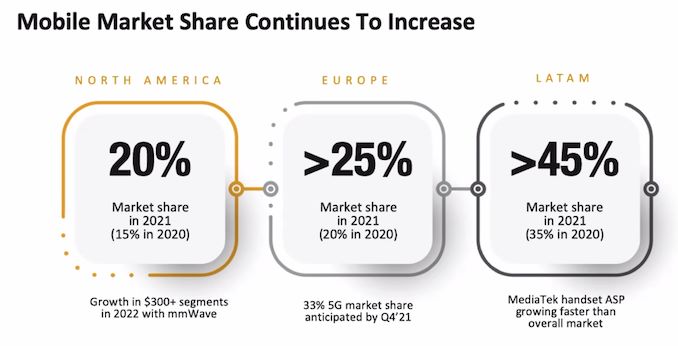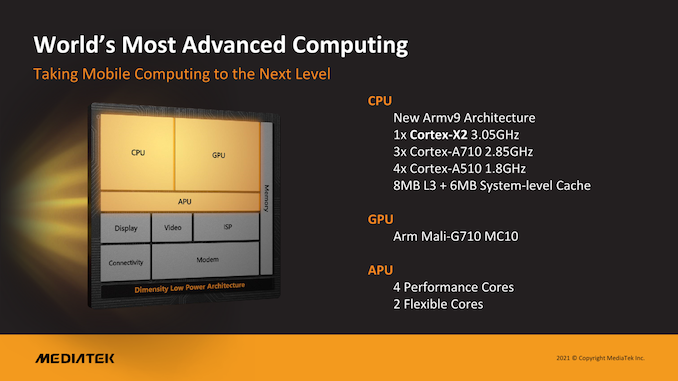MediaTek Announces Dimensity 9000: Supercharged Flagship SoC on 4nm
by Andrei Frumusanu on November 18, 2021 6:00 PM ESTConclusion & First Impressions
MediaTek’s re-entry in the flagship SoC space with the Dimensity 9000 comes at quite the opportunistic time in the landscape. The company has had a very successful 2021 with large market share gains, and we’ve even seen this translate into more exposure in more visible design wins in the market, such as the OnePlus Nord 2 series or the Xiaomi 11T.
Having seen large market share gains and being able to fill in a huge gap in the market where Huawei and HiSilicon were in the past, the Dimensity 9000 seems to have come at the perfect time, as more vendors want to be able to differentiate their highest end devices and diversify their reliance on Qualcomm’s Snapdragon series.
The Dimensity 9000, on paper, and by the specification, looks like an extremely strong SoC for 2022 flagships. On the CPU side of things, MediaTek has fully equipped the SoC with near the maximum possible configuration – high frequencies, large caches, and surprisingly enough for us today, a full performance configuration of the new Cortex-A510 cores. The 8MB L3 is helped by a new 6MB system cache that further improves memory performance, which the Dimensity 9000 of is currently the first and only chip to support new LPDDR5X.
The GPU side, the chip likely will be the only design for 2022 with a large Mali GPU. Advertised performance figures are good, but what matters most is power efficiency and sustained performance. While the metrics here are still a bit vague, the N4 process node of the chip, again, the first of its kind, is likely to position the chip in an excellently against 2021 devices, and if Qualcomm and Samsung don’t have major leaps in their upcoming designs, also position the Dimensity 9000 extremely well against the 2022 competition.
MediaTek’s camera and ISP leaps are also just huge. We haven’t really had many camera-centric phones powered by MediaTek silicon over the last few years, so if vendors are able to take advantage of the chip’s new camera architecture remains to be seen, but at least the high-level specifications are definitely worthy of 2022 flagships.
The chip’s lack of mmWave is likely limit its success to non-US markets and devices, but that’s a situation we generally become used to over the years.
The Dimensity 9000 is MediaTek’s strongest showing in years, and has the specifications and heft to properly shake up the high-end market. I see it competing against, or even besting whatever Qualcomm has in queue for next year, which is a pretty shocking turn of events. What matters now, is for MediaTek to actually have the high-profile flagship device design wins, to be able to fully rationalise their investment in such a SoC. Luckily, we’ve been told the chip has already sampled to customers, and we’re to expect commercial device launches in the first quarter of 2022. Exciting times are ahead in the mobile SoC space.












150 Comments
View All Comments
ChrisGX - Thursday, November 25, 2021 - link
The two statements that you take as contradicting one another are actually consistent - they refer to different matters. For an implementation of the G710 on the same silicon process as the predecessor G78 (TSMC N5) if power is held constant the Mali-G710 will offer a 20% performance improvement. However, the structure of the Mali cores change with the G710. You are only going to need roughly half of the number of cores to achieve equivalent performance to the earlier generation G78. The cores of the G710 are faster, bigger and more power hungry but in a sensible GPU configuration in an ARM SoC they offer a 20% energy efficiency boost in an ISO Process implementation.If the Dimensity 9000 is anything to go by it looks like ARM premium SoC manufacturers will be looking for big gains in GPU performance (much more than 20%) and they will be willing to pay a power consumption price to get it. So, with ARM SoCs in flagship Android phones already operating at the power limit for such devices power savings will have to be made elsewhere if sustainable performance is to see solid gains in 2022 phones.
tobichii6 - Friday, November 19, 2021 - link
I will not belive until they be friendly with open-source community as GNU GPL v2. Look at Qualcomm, they're still superior, of course their hardware decoder like AV1 Is I think still behind (update on me for this) but they can still whip your butt because of their soon snapdragon cpu. This is just talking of new architecture cpu meanwhile does not represent average software update, and plus it's a pain in the arse to mod a MediaTek device. And that's not funny at all. Because devices tend to go old, We need a source code so our devices would last long.
Change your policy about the source code to getting open then we're talking (all android chipset in mtk family must be open)
dwillmore - Friday, November 19, 2021 - link
Please don't use SLC for System Level Cache as SLC is already used for flash memories. It's going to cause confusion.FunBunny2 - Friday, November 19, 2021 - link
"SLC is already used for flash memories"SLC was used for flash memories
it's been a while since there was any SLC on sale anywhere.
Wereweeb - Friday, November 19, 2021 - link
There's plenty in servers, and almost all SSD's use their cells in pSLC mode for caching. The FuzeDrive uses it for tiering.mode_13h - Saturday, November 20, 2021 - link
I think it's the nomenclature ARM is using, though. It's reasonable to have a distinct term for cache that's shared among all the CPU cores *and* accelerator blocks, so I don't mind them not simply calling it L3 or LLC.Boss Win - Friday, November 19, 2021 - link
Too many Qualcomm employee attacking a chinese city taipei company MediaTek.Biggest excuse is communism stole tech. While capitalism stole Hawaii, California, New Mexico, and the whole USA.
And yeah, happy thanksgiving.. where people saved you from your winter deaths only to be killed by you after.
Stupid white men who want to rape 13 year old Pocahontas.
Raqia - Friday, November 19, 2021 - link
Their issue has always been software support which lags other vendors:https://www.androidauthority.com/qualcomm-mediatek...
Not to mention driver cheats. The part does look like the ARM presentation's '22 reference high end implementation and good on paper so hopefully it spurs more competition and innovation. HBM stacks on phones maybe? Split, mammoth sized CPU and GPU chiplets?
mode_13h - Saturday, November 20, 2021 - link
Cost is probably a big issue with both of those. We're likely to see stacked memory in laptops first (like what Apple did), before it ever reaches phones. I doubt if HBM can be power-efficient enough, which is probably why Apple went with LPDDR5, in the M1 Pro and Max.And a dedicated GPU chiplet in phones? Doesn't seem likely. Maybe if yields of even newer processes are poor.
wjohnas - Saturday, November 20, 2021 - link
Samsung's Exynows 2100 already supports 8K@60fps AV1 Decoding, I don't know what Mediatek talking about